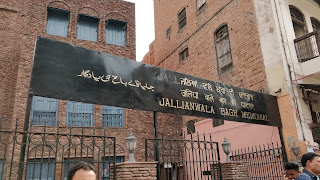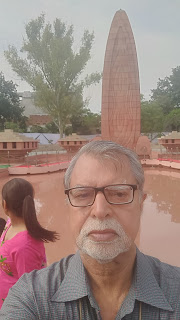Khooni Baisakhi
(Bloody Baisakhi) of 1919-Rowlatt act-hundred years later similar laws continue
Chaman
Lal*
History
is said to repeat itself, first as a tragedy and then as a farce. This is
happening hundred years later in case of Jallianwala Bagh centenary
celebrations also. While British Parliament has discussed this event as matter
raised by Indian background Parliament members and Prime Minister Theresa May
had to respond by ‘deeply regretting’ the incident, but not ‘apologising’ for
the British colonial Raj’s atrocities on Indian people. While we expect British
colonial past to be condemned by the present British rulers, what is our response
to this monumental event of the century, which became a perennial phrase for
all the atrocities committed and being committed by any ruler-British and later
‘Desi’ rulers of various hues-be it Congress or now BJP! ‘One more Jallianwala
Bagh’ phrase has been used for any atrocity committed by police or armed
forces, sometimes used even farcically also, as for killing of a student,
farmer, worker or common man. Not that the killing even of a single person is
justified, but the use of such phrase as ‘one more Jallianwala’ reduces the
monumental tragedy of Jallianwala Bagh to a convenient political jugglery.
The background of Jallianwala Bagh goes
back to 1918, when Lord Chelmsford formed a formed a sedition committee led by
Lord Sidney Rowlatt, this committee discussed the increasing revolutionary activities
in Punjab and Bengal especially, as Ghadar party movement erupted in 1915.
Sedition committee report was submitted in April 1918 and based on that report
a new oppressive act-The Anarchical and Revolutionary Crimes act of 1919,
popularly known as Rowaltt act or Black act was passed in Imperial legislative
council in Delhi on 10th March 1919, resisted by Indian members
stoutly. It created strong reaction among Indian leaders of that time and Mahatma
Gandhi, who was shaping into a national leader gave a call for strike on 30th
March 1919. As the notice for strike was considered short, it was postponed to
6th April to be observed as national strike. Still on 30th
March also, strike was observed in many places including Delhi, where some
violence took place and in retaliation much worse police atrocities too took
place. In that year Congress party was planning to hold its session in
Amritsar. As Mahatma Gandhi had not visited Punjab anytime before, he took
train to Punjab to reach before 6th April national strike, however
after 30th March Delhi protests, he was not even allowed to enter
Delhi and was stopped at Palwal and sent back.
Disturbances in Amritsar and Punjab
took sharp turn. 9th April was Ram Naumi day in 1919, Dr. Satya Pal
and Saifuddin Kitchlew were two popular congress leaders of Punjab. With their
influence Ram Naumi this year was celebrated by Hindus and Muslims jointly.
This frightened British rulers as Hindu Muslim unity was earlier shown in 1857
and then in 1915 Ghadar movement. Both Dr. Satya Pal and Dr. Saifuddin Kitchlew(A
Cashmere settled in Amritsar) were arrested by deceit on 10th April,
they were invited for talks at Deputy Commissioner and were arrested and sent
out of Punjab to some undisclosed location. This angered the general public.
There were clashes with police on 11th April One British lady
Sherwood was attacked as some male British officials. Sherwood was rescued, but
few other British officers were killed. Protest meetings were called and 25
people died protesting on Bhadari bridge. On 13th April, a public
meeting was called at 4.30 pm in Jallianwala Bagh, a common meeting place for
citizenery. While General Dyer had moved from Jalandhar to Amritsar a day
earlier with support from Michael O’Dwyer, Lieutenant Governor of Punjab.
General Dyer took his forces to Jallianwala Bagh with only a narrow exit and
without any warning to disperse, started firing incessantly on people directly.
In ten minutes, 1650 rounds of firing were done and hundreds of people were
turned into dead bodies in few minutes. No medical aid was provided, many people
could have been saved, but the terror in whole city was such that during whole
night of 13th April, people kept dyeing without water, medical aid.
Only next morning people could reach the Bagh and render help to dead and half
dead bodies there. Bhagat Singh visited Bagh next day and got one jar filled
with blood-soaked sand of the Bagh, which is still preserved in Khatkar Kalan
memorial museum in Bhagat Singh’s ancestral village.
The details of tragedy are being relived in
pages of The Tribune and many other papers after hundred years. Martial law was
clamped all over Punjab by 15th April and General Dyer ordered
crawling of citizens crossing the narrow lane in Amritsar, where lady Sherwood
was attacked and rescued. Thousands of men, women, old and children were made
to crawl for many yards and were flogged as well in that street for many days. In
many other cities like Gujranwala, Lahore and other places massive repression
took place.
Poets and writers expressed the
anguish of people in their writings, many of which were banned. Subhadra Kumari
Chauhan, Nanak Singh, Feroz Din Sharaf and many more poets and writers
expressed their anguish. Nanak Singh, who was in his twenties at that time, was
in Bagh for the meeting and was lying under dead bodies, got escaped next day
and aptly titled his poem Khuni Baisakhi(Bloody Baisakhi), written after a
year, which was banned and has now been translated in English by his grandson
Navdeep Suri.
Mahatma Gandhi withdrew his
Satyagraha by 19th April. Tagore renounced his knighthood given by
British colonialists. People suffered for months together and generations suffered
the memories of tragedy and still suffer.
Many questions arise, when celebrating the
centenary of such monumental tragedy. Such tragedies are norm of colonial
rulers and not exception. Much worse atrocities took place in Mau Mau movement
of Kenya five decades later between 1952 to 1959. Assessment of killings vary
from official 11000 to three million in anther extreme. Moderate assessment is
of 25000 killings. In Jallianwala Bagh official number in 379, but Congress
report number is about one thousand. Ram Singh Majithia in his two-volume book
in Punjabi published in sixties listed nearly 460 deaths, he even put the names
and break up of Hindus, Sikhs and Muslims killed jointly during the firing. Lately
Amritsar district administration have collected names of 500+ victims of
massacre. British colonial administration started paying pittance of
compensation after a gap of more than one year, many families never approached
out of fear or lack of information. Compensation was largely paid from fifty
rupees to few hundred rupees in large number of cases, whereas only in one case
perhaps one lakh plus rupees were paid as compensation. The value of human life
was counted as per class of the persons, poor people’s deaths were paid in just
few hundred bucks, richer people’s deaths earned bit more.
When there is talk of apology, present British
rulers feared the demand for compensation will arise with apology. And why
should the demand not arise? Few years ago, a British court has ruled British
Government to pay millions of pounds to survivors or decedents of Mau Mau
movement. Why Jallianwala Bagh be treated differently, successors of colonial
rulers must be made to pay for their systemic crimes. Colonialism was a system
approved by successive Parliaments of Britain and continuity demands the
compensation from present rulers as well Rulers don’t pay from their pockets,
they pay from public funds and Brittan as colonial power had squeezed Asian and
African colonised countries ruthlessly to enrich British ruling classes or
British bourgeoise , a part of return of colonial loot is totally justifiable
and just action, as done by a British court.
But do the Indian ruling classes have the
guts to ask for compensation for British colonial crimes? Indian ruling classes
don’t give much importance to Jallianwala Bagh historic tragedy as supreme symbol
of Indian freedom struggle, otherwise how come that for centenary celebrations,
head of the state-President of India is not going there. Sending Vice President
for the centenary function is just undermining, even disrespecting the
significance of the monumental tragedy.
Not only that, Indian ruling classes are
following British colonial practices, a ban has been imposed in Amritsar and
Jallianwala Bagh for the free movement of people to pay homage to martyrs of
Jallianwala Bagh. Many peasant, workers, student and youth organisations have
planned marches to Jalliawala Bagh monument, which has been put to
restrictions. Tragedy of people has been turned into celebration of VIP’s. And
further more, Indian ruling classes are continuing with such oppressive laws as
Rowlatt act after a hundred years of the tragedy. British colonialism was
forced to withdraw that act in three years. Rowlatt act was withdrawn by 1922,
but what about DIR, MISA, UAPA and AFPSA continuing for decades in ‘desi’
rulers ruled India. Was not Bhagat Singh correct in observing that it hardly
makes any difference if Purshottam Das Thakkar or Sir Tej Bahadur Sapru become
Viceroys in place of Lord Reading or Lord Irwin, if the system of oppression
and exploitation continues and who can say that system of exploitation and
oppression has ended with British rule. Worse still the communal cauldron is
made to burn, a Lok Sabha candidate Kanhaiya Kumar has alleged that RSS/BJP is
trying to stoke Hindu-Muslim riots in 2019 Ram Naumi falling during elections
and you see 1919 April Ram Naumi celebrated jointly by Hindus and Muslims in
fervour. Muslim even served sweet water to their Hindu brethren during the
festival. Dr. Saifuddin Kitchlew and Dr. Satya Pal were the symbols of
Hindu-Muslim unity and brotherhood during national movement and that unity and
brotherhood is put to danger by so called ‘nationalists’ of 2019!
Have we really learned lessons from-Jallianwala
Bagh-the monumental tragedy! Meanwhile our ‘Desi’ rulers continue with communal
massacres of bigger scale than Jallianwala Bagh massacres; #Delhi1984, #Gujarat2002,
#3LakhPeasantSucides in 21st century and of course British rulers
must apologise and compensate for Jallianwala Bagh, but our ‘Desi’ rulers are
free to commit any atrocities on our people! After all they are ‘Desi’-free
India rulers, why should they apologise or compensate?!












No comments:
Post a Comment